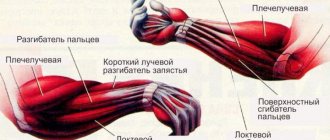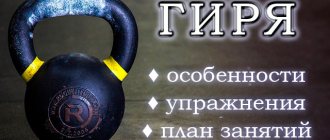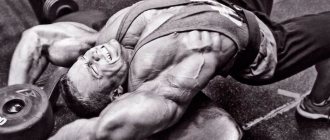Training with a kettlebell can provide a high-quality load on absolutely all muscle groups. Many exercises with apparatus are easy to perform, so they are great for both beginners and advanced. The main feature of such classes is the development of strength skills and endurance, strengthening of all muscle groups.
What are the benefits of kettlebell swings?
Develop stamina and burn a lot of calories
In one small experiment, R. E. Farrar, J. L. Mayhew, A. J. Koch. Oxygen cost of kettlebell swings / Journal of strength and conditioning research, scientists compared heart rate (HR) and maximum oxygen consumption (VO2) during running and interval training with 16 kg kettlebells. And we ended up with similar results.
Both kettlebell swings and running increased my heart rate to an average of 165 beats per minute. By training at this heart rate, a person weighing 70 kg can burn about 250 kcal in 20 minutes.
In another experimentC. R. Hulsey, D. T. Soto, A. J. Koch, J. L. Mayhew. Comparison of kettlebell swings and treadmill running at equivalent rating of perceived exertion values / Journal of strength and conditioning research with the participation of 13 young people also found that running and kettlebell swings increased heart rate approximately equally - up to 89-90% of the maximum.
In terms of maximizing oxygen consumption and calorie expenditure, running won in this study, but scientists recognized that kettlebell swings are also effective for developing endurance.
However, if you want to use this movement as a replacement for cardio, work intensely. In one study, K. Jay, D. Frisch, K. Hansen, MK Zebis, CH Andersen, OS Mortensen, LL Andersen. Kettlebell training for musculoskeletal and cardiovascular health: a randomized controlled trial / Scandinavian journal of work, environment & health involving 40 people. 8 weeks of kettlebell training did not increase participants' endurance. In another scientific work they noted J. P. Lake, M. A. Lauder. Kettlebell Swing Training Improves Maximal and Explosive Strength / Journal of strength and conditioning research that this may be due to the low weight of the apparatus: in the experiment, kettlebells weighing 4 kg for women and 8 kg for men were used, while in other studies the apparatus was 12 –16 kg.
Good load on the gluteal muscles
Correct execution of kettlebell swings includes powerful extension in the hip joint - it is this movement that gives the projectile inertia for lifting, and it also provides a good load on the gluteal muscles.
One study tested how hard kettlebell swings and snatches hit different muscle groups. It turned out that during swings the gluteus maximus muscles are activated. S. McGill, L. W. Marshall. Kettlebell Swing, Snatch, and Bottoms-Up Carry: Back and... / The Journal of Strength & Conditioning Research at 76% of maximum voluntary contraction, and the gluteus medius at 70%.
Can improve absolute and explosive strength
In the study by J. P. Lake, M. A. Lauder. Kettlebell Swing Training Improves Maximal and Explosive Strength / Journal of strength and conditioning research involving 21 men compared the effects of kettlebell swings and jumping on the development of explosive and maximal strength.
After 6 weeks of training, the youth in the kettlebell group increased their one-rep maximum in squats by 12%, while those in the jumping group increased their one-rep maximum by only 7.7%. Vertical jump performance naturally increased among those who jumped (by 24%). However, in the swing group the increase was significant (15%).
Scientists have concluded that kettlebell swings improve not only aerobic endurance, but also explosive and maximal strength.
The same thing was observed in another experiment P. Manocchia, DK Spierer, AKS Lufkin, J. Minichiello, J. Castro / Journal of strength and conditioning research with the participation of 37 people. 10 weeks of kettlebell training (swings, presses, rows, snatches) twice a week significantly increased three-rep max in the snatch and bench press.
The study concluded that the ballistic and explosive components of kettlebell training carry over to other disciplines, including weightlifting and powerlifting.
May help with shoulder, neck and lower back pain
In one small study, K. Jay, D. Frisch, K. Hansen, MK Zebis, CH Andersen, OS Mortensen, LL Andersen. Kettlebell training for musculoskeletal and cardiovascular health: a randomized controlled trial / Scandinavian journal of work, environment & health 40 people with pain in the lower back (intensity - 2.8 points out of 10), shoulders and neck (3.5 points out of 10) completed after 8 weeks of training with kettlebells.
At the end of the experiment, discomfort in the neck and shoulders decreased by 2 points, and in the lower back by 1.4. Thus, even not particularly intense exercises with kettlebells can relieve back pain by half, and even more significantly in the neck and shoulders.
Blitz tips
- For safe training, you need to have not only good physical fitness, but also clear coordination so as not to lose your balance;
- If this is your first time training with this device, then it is advisable to be under the supervision of a trainer who can insure you in time and explain the rules of working with a kettlebell;
- You should not do such training every day, since the muscles need rest and time to recover;
- You should know that for exercise you need to select special sports shoes with flat soles (sneakers are best), since ordinary shock-absorbing running shoes will be uncomfortable here. In addition, the best option is to train without shoes at all, since in this position you will be able to feel the floor and stand firmly on it, maintaining your balance.
Dear visitors, if you find an error, please select a piece of text and press Ctrl Enter. The error will be sent to us and we will fix it, thank you in advance.
Who Shouldn't Do Kettlebell Swings
In the study mentioned above, K. Jay, D. Frisch, K. Hansen, MK Zebis, CH Andersen, OS Mortensen, LL Andersen. Kettlebell training for musculoskeletal and cardiovascular health: a randomized controlled trial / Scandinavian journal of work, environment & health kettlebell swings were done with a small weight - 4–8 kg. They were performed after lead-up exercises and under the supervision of a trainer.
The use of heavier projectiles, especially if there are flaws in the technique, can negatively affect health.
ResearchersM. S. McGill, L. W. Marshall. Kettlebell Swing, Snatch, and Bottoms-Up Carry: Back and… / The Journal of Strength & Conditioning Research found that during kettlebell swings, significant shearing forces are applied to the lumbar spine, which, together with compression, can harm the back.
American kettlebell swings, in which the projectile is raised above the head, are considered especially dangerous in this regard.
Scientists from Bridgewater State University found S. Oikarinen. American Kettlebell Swing and the Risk of Lumbar Spine Injury / Bridgewater State University that from the moment of full hip extension until the top of the exercise is reached, the lower spine deviates from the neutral position by 25°. This greatly increases the compression load and can lead to injury.
Therefore, if you already have lower back problems, before performing kettlebell swings - especially American ones - consult your doctor and master the movements under the supervision of a trainer.
Important point
Before starting strength training, you should definitely see a doctor, preferably a sports doctor, in order to identify any contraindications for this sport. Strength exercises are contraindicated in certain diseases of the cardiovascular system (including varicose veins and hemorrhoids), gastrointestinal tract, liver and biliary tract, respiratory tract, urinary system, visual impairment (especially with a high degree of myopia), disorders with aspects of the musculoskeletal, nervous and endocrine systems.
If physical exertion during strength exercises exceeds the capabilities of a given person’s body, then irreparable harm can be caused to him.
You should know that such exercises are quite traumatic, so you need to do them very carefully. Also, they have the following contraindications:
- Pregnancy.
- Heart diseases.
- Disorders of the musculoskeletal system.
- Periods after fractures and surgical interventions, when not yet a year has passed since (it is better not to risk your health and fully recover before such stress).
- Haemorrhoids.
- Rachiocampsis.
How to perform kettlebell swings
There are several N. J. Meigh, J. W. L. Keogh, B. Schram & W. A. Hing. Kettlebell training in clinical practice: a scoping review / BMC Sports Science, Medicine and Rehabilitation of types of kettlebell swings that differ from each other in technical terms:
- Russian kettlebell swings are the most common option, which does not require long mastery or special physical training. In this design, the projectile rises only to the level of the chest (clavicles).
- The American Kettlebell Swing is a variation in which the kettlebell moves over a wider range and is raised above the head with extended arms. Most often this method can be found in CrossFit.
- One-arm kettlebell swing with a double squat - this variation is used in kettlebell lifting and is essentially one of the phases of the competitive kettlebell snatch movement.
If you are not going to compete in CrossFit or kettlebell lifting, choose Russian swings.
How to perform Russian kettlebell swings
Stand with your feet shoulder-width apart, place the weight in front of your toes at a distance of about 30 cm.
Bend your knees slightly and lean forward with your back straight. Grasp the handle of the kettlebell with an overhand grip, lowering your shoulders and shoulder blades to engage your lats.
Lift the bar off the floor, then, keeping your back straight, bend at the hip and swing the weight back between your legs. There is no need to do squats in this phase.
At the same time, the legs at the knees also bend, but only slightly. In the video below, BJ Gaddour from Men's Health shows the correct position during the backswing.
Next, sharply straighten up at the hip and knee joints, giving the weight acceleration. Do not strain your arms: the projectile should fly forward due to the extension of the hips. Imagine that your hands are two ropes to which a weight is attached.
When the projectile reaches the level of your collarbones, let it fall along the same trajectory and bring it back between your legs.
Make sure to maintain a neutral lower back position: do not slouch during the swing phase, but do not arch in the lower back either. Keep your neck in line with your back, do not lift your head to look forward when bending over.
Pay attention to your feet: they should stand firmly on the floor, without leaving it during any phase of the exercise.
If the handle of the kettlebell slips, use chalk to prevent the weight from falling out of your fingers during the swing.
How to do American Kettlebell Swings
The first phase of this exercise is the same as in the Russian version.
You bend at the hip with a neutral spine and slide the kettlebell between your legs. Then you straighten up, raising the projectile in front of your body with outstretched arms.
Only in the American swing is the kettlebell brought to a position above the head and only then lowered along the same trajectory.
Because you need to lift the kettlebell higher, this exercise will require a more powerful swing, which will increase the energy cost of the movement and make it more difficult.
Therefore, if you are doing well with the Russian version, before doing the American one, change the weight to a lighter one in order to get comfortable with the technique and not injure your shoulders.
How to do a one-arm kettlebell swing with a double squat
Stand with your feet shoulder-width apart and place the weight about 30 cm from your toes. Lean towards it with your back straight and grab the handle with one hand. Hold the second one freely at a distance from the body.
To avoid overloading your forearms, pay attention to your grip. Don't squeeze the kettlebell too hard. Instead, form a four-finger hook and slide the projectile onto it, then press your index finger with your thumb to form a lock.
Lift the kettlebell and swing back between your legs. When the projectile passes the line of your feet, straighten your limbs at the knees while maintaining the tilt of the body.
Then, with an additional squat, bring the weight forward, straightening the body, as well as the legs at the hip and knee joints. Squatting between the swing and releasing the projectile in front of you provides more inertia, so you can swing with one arm without working your shoulder muscles.
When the weight reaches shoulder level, allow it to fall along the same trajectory and at this time bend your legs at the hip and knee joints. At the extreme point of the swing, when the projectile is between your legs, straighten up again and start again.
How to Add Kettlebell Swings to Your Workout
This exercise can be performed either alone or in combination with other movements. Below we present several options.
Swing kettlebells at equal intervals
Do kettlebell swings for 30 seconds without stopping, then rest for the same amount and start again. Perform 10–20 laps depending on your physical fitness and availability of free time.
Tabata with kettlebell
This training was used in one studyB. M. Williams, R. R. Kraemer. Comparison of Cardiorespiratory and Metabolic Responses in Kettlebell High‑Intensity Interval Training Versus Sprint Interval Cycling / Journal of strength and conditioning research and allowed participants to burn about 144 kcal in 12 minutes.
Perform the first exercise for 20 seconds, then rest for 10 seconds and repeat the same thing - 20 seconds of work and 10 seconds of rest.
Then move on to the next element and do it exactly the same way - two rounds of 30 seconds (20 for load and 10 for rest). After finishing the last exercise, start again. Do three circuits.
The complex includes:
- Kettlebell sumo squats - two rounds.
- Kettlebell swings - two rounds.
- Kettlebell clean and press up - two rounds.
- Sumo deadlift with kettlebell - two rounds.
The video below demonstrates the technique.
Interval training 40/20
Do the following exercises:
- Jumping rope - single or double.
- Thrusters with dumbbells - select the weight so that you can do about 15 reps per set.
- Kettlebell swings.
- "Bike".
Do each for 40 seconds, then rest until the end of the minute and move on to the next element. When you finish the last exercise, start again. Three to five laps will be enough.
Diet
When training with weights for results, it is absolutely necessary to follow a diet, following the following rules:
- divide your daily diet into 4-6 servings;
- the optimal break between meals is 3.5 hours;
- always have breakfast;
- be sure to include carbohydrates and proteins in the menu;
- have dinner 2 hours before bedtime with protein foods;
- eat 1.5 hours before training.
Remember, sausage, candy, canned food, alcohol, smoked foods are all products that are useless for health.











